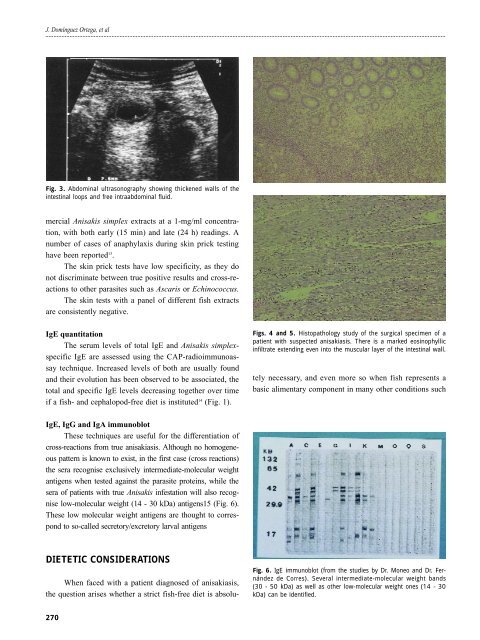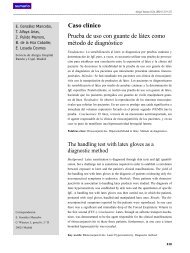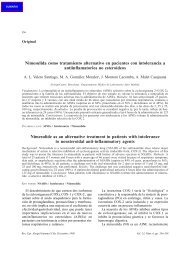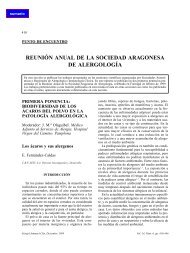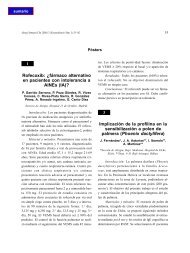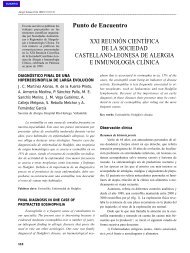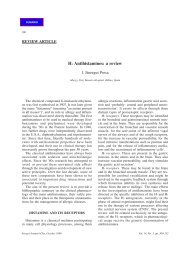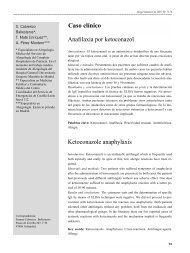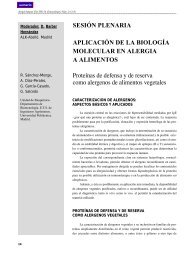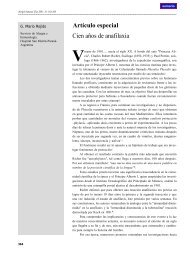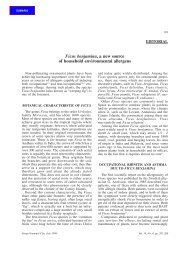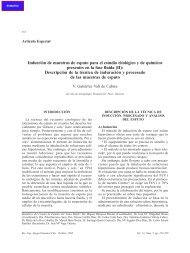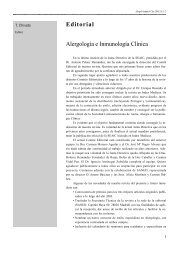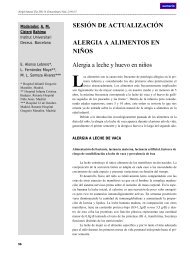Guidelines in pathology induced by Anisakis Original Article
Guidelines in pathology induced by Anisakis Original Article
Guidelines in pathology induced by Anisakis Original Article
You also want an ePaper? Increase the reach of your titles
YUMPU automatically turns print PDFs into web optimized ePapers that Google loves.
J. Domínguez Ortega, et al<br />
Fig. 3. Abdom<strong>in</strong>al ultrasonography show<strong>in</strong>g thickened walls of the<br />
<strong>in</strong>test<strong>in</strong>al loops and free <strong>in</strong>traabdom<strong>in</strong>al fluid.<br />
mercial <strong>Anisakis</strong> simplex extracts at a 1-mg/ml concentration,<br />
with both early (15 m<strong>in</strong>) and late (24 h) read<strong>in</strong>gs. A<br />
number of cases of anaphylaxis dur<strong>in</strong>g sk<strong>in</strong> prick test<strong>in</strong>g<br />
have been reported 13 .<br />
The sk<strong>in</strong> prick tests have low specificity, as they do<br />
not discrim<strong>in</strong>ate between true positive results and cross-reactions<br />
to other parasites such as Ascaris or Ech<strong>in</strong>ococcus.<br />
The sk<strong>in</strong> tests with a panel of different fish extracts<br />
are consistently negative.<br />
IgE quantitation<br />
The serum levels of total IgE and <strong>Anisakis</strong> simplexspecific<br />
IgE are assessed us<strong>in</strong>g the CAP-radioimmunoassay<br />
technique. Increased levels of both are usually found<br />
and their evolution has been observed to be associated, the<br />
total and specific IgE levels decreas<strong>in</strong>g together over time<br />
if a fish- and cephalopod-free diet is <strong>in</strong>stituted 14 (Fig. 1).<br />
IgE, IgG and IgA immunoblot<br />
These techniques are useful for the differentiation of<br />
cross-reactions from true anisakiasis. Although no homogeneous<br />
pattern is known to exist, <strong>in</strong> the first case (cross reactions)<br />
the sera recognise exclusively <strong>in</strong>termediate-molecular weight<br />
antigens when tested aga<strong>in</strong>st the parasite prote<strong>in</strong>s, while the<br />
sera of patients with true <strong>Anisakis</strong> <strong>in</strong>festation will also recognise<br />
low-molecular weight (14 - 30 kDa) antigens15 (Fig. 6).<br />
These low molecular weight antigens are thought to correspond<br />
to so-called secretory/excretory larval antigens<br />
DIETETIC CONSIDERATIONS<br />
When faced with a patient diagnosed of anisakiasis,<br />
the question arises whether a strict fish-free diet is absolu-<br />
270<br />
Figs. 4 and 5. Histo<strong>pathology</strong> study of the surgical specimen of a<br />
patient with suspected anisakiasis. There is a marked eos<strong>in</strong>ophyllic<br />
<strong>in</strong>filtrate extend<strong>in</strong>g even <strong>in</strong>to the muscular layer of the <strong>in</strong>test<strong>in</strong>al wall.<br />
tely necessary, and even more so when fish represents a<br />
basic alimentary component <strong>in</strong> many other conditions such<br />
Fig. 6. IgE immunoblot (from the studies <strong>by</strong> Dr. Moneo and Dr. Fernández<br />
de Corres). Several <strong>in</strong>termediate-molecular weight bands<br />
(30 - 50 kDa) as well as other low-molecular weight ones (14 - 30<br />
kDa) can be identified.


